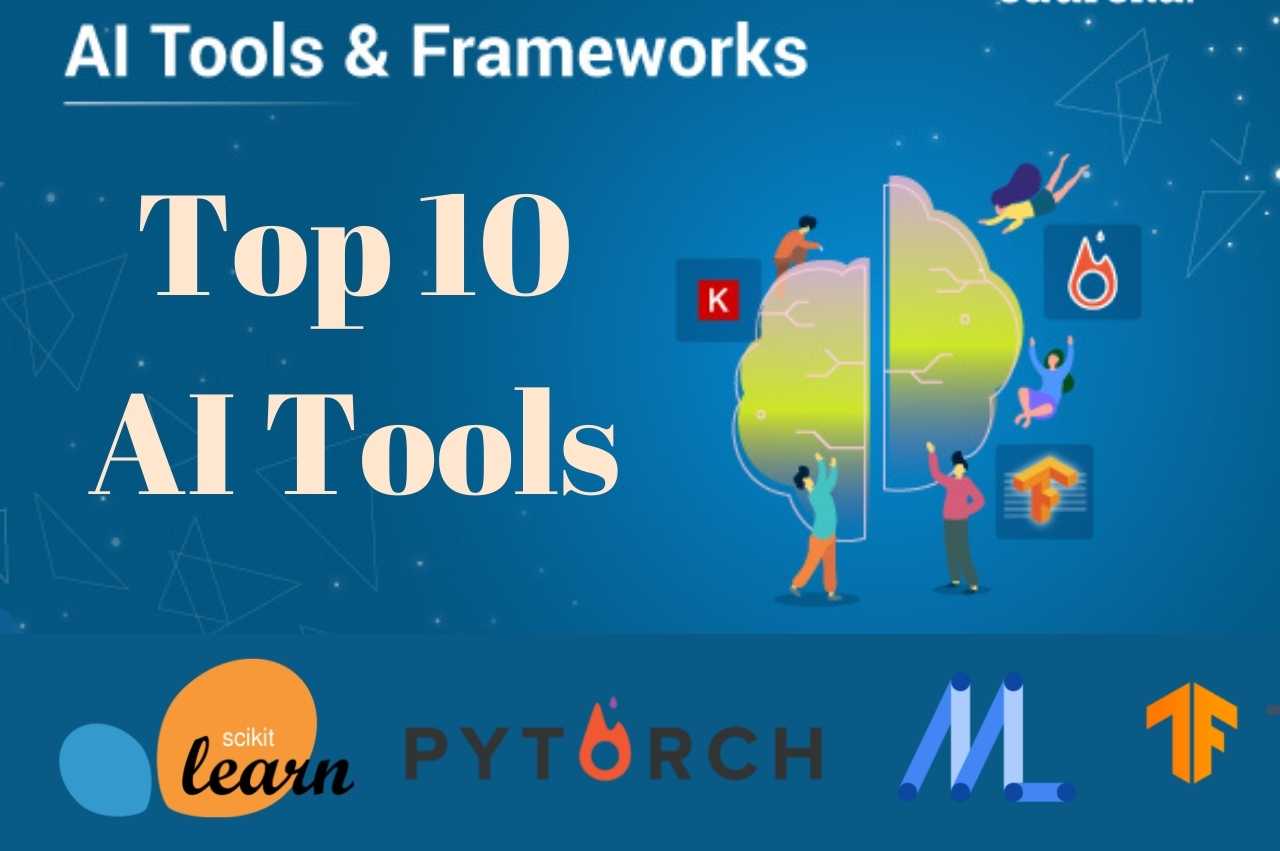Data is a new oil and we are all producing vast amounts of data every day. Artificial Intelligence (AI) and Machine learning (ML) have facilitated the processing of a large amount of data and its use in the industry. With the growth in AI and ML, several frameworks and Artificial Intelligence tools have been made available to developers and scientists. Here we are listed the top 10 Artificial intelligence tools and frameworks to learn that are available in the market.
Top 10 AI tools And Frameworks
Below is the list of the 10 best AI tools and frameworks for learning artificial intelligence. You can choose from these artificial intelligence (AI) tools depending on what best meets your requirements.
1. TensorFlow

Whether you are an expert or a beginner, TensorFlow is the ultimate platform that makes it easy for you to build and use an ML model.
TensorFlow offers a wide range of abstractions so you can choose the one that best suits your needs. Build and train models using the advanced Keras API, which makes getting started with TensorFlow and machine learning easier.
If you need more flexibility, doing it with enthusiasm allows for quick repetition and accurate debugging. For large ML training tasks, use the Distribution Strategy API to get distributed training in the configuration of different computer systems without changing the model description.
TensorFlow has always provided a direct path to production. Whether it’s on servers, edge devices, or the web, TensorFlow lets you train and deploy your model easily, no matter what language or platform you use.
t underpins many administered and unsupervised learning calculations
2. Scikit Learn
Scikit-learn is one of the most popular ML libraries. It underpins many administered and unsupervised learning calculations.
1. It extends to two main Python libraries, NumPy and SciPy.
2. Includes a wide range of common AI statistics and data mining operations, including integration, duplication and layout. Indeed, even tasks such as information exchange, feature determination and integration techniques can be done in a few lines.
Some Features are:

- Simple and efficient tools for predictive data analysis
- Accessible to everybody, and reusable in various contexts
- Built on NumPy, SciPy, and matplotlib
- Open source, commercially usable – BSD license
New to ML, Scikit-learn is a tool enough to work with, until you start doing complex math little by little
3. Keras
If you like Python’s way of doing things, Keras is for you. It is a state-of-the-art library for neural networks, using TensorFlow or Theano as its backbone.

Most functional problems are like this:
>> Choosing the right structure for the problem,
>> With image recognition problems.
>> Network configuration to prepare results (long, repetitive process).
In all of this, Keras is a gem. Also, it provides an invisible structure that can be easily adapted to other structures, if needed (in conjunction, function and anything).
4. PyTorch
PyTorch is an open-source machine learning framework based on the Torch library created by Facebook. PyTorch. It is based on the Python programming language. It is one of the preferred platforms for deep learning research. The framework is built to speed up the process between research prototyping and deployment. Its code is accessible on Github with more than 25K stars.
5. Google ML Kit
Google ML Kit, the Google beta learning machine for mobile developers, is designed to enable developers to build personalized features for Android and IOS phones.

The kit allows developers to embed machine learning technology with application-based APIs running on a device or cloud. This includes features such as face recognition and text, barcode scanning, photo labelling and more.
Developers are also able to build their own TensorFlow Lite models in situations where built-in APIs may not be suitable for use.
6. Theano
Theano is wrapped up on Keras. Keras is a central Python library that allows for in-depth discoveries working on Tensorflow or Theano. Theano is designed to create in-depth learning models and make them simpler and quicker to do in a creative endeavour. Works on Python and can be done on GPUs and CPUs. Theano can use a PC GPU. This allows it to perform incremental data calculations, which are more frequent than when stored on the CPU only. The speed of Theano makes it very profitable to do any complex calculations.
7. Auto ML
Of all the tools and libraries listed above, Auto ML is probably one of the most powerful and latest additions to the available learning engine toolbox tools.

As described in the introduction, preparation is an important part of machine learning activities. Although the benefits can be great, success in determining the right hyperparameter is not an easy task. This is especially true in the black box as neural networks where determining the essentials becomes more difficult as network depth increases.
So we enter a new meta world, where software helps to build software. AutoML is a library used by many machine learning engineers to improve their models.
Aside from the obvious time saved, this can also be extremely useful for someone who does not have a lot of experience in the field of machine learning and thus lacks intuition or previous experience in making certain hyperparameter changes alone.
8. OpenNN
Jumping from something that is a good start to something aimed at experienced engineers, OpenNN offers a collection of advanced statistics.
Includes a tool, Neural Designer for advanced analysis that provides graphs and tables to interpret data entries.
9. H20: Open Source AI Platform
It is an open-source deep learning platform. It is a business-oriented intelligence tool that helps them make informed decisions with data and enables the user to draw information. There are two types of open-source: one is the standard H2O and the other is the paid version of Sparkling Water. It can be used for model prediction, risk analysis and fraud, insurance analysis, marketing technology, health care and customer intelligence.
10. Caffe
Caffe is an in-depth learning structure made with definition, speed, and limited quality as the most important factor. Created by Berkeley Vision and Learning Center (BVLC) and network sponsors. Google DeepDream relies on Caffe Framework. This building is a C ++-approved BSD library with Python Interface.
Conclusion
The above is the list of the top Artificial Intelligence tools and Frameworks that are used by engineers and data scientists to solve some real-life problems, making sub-system structures stronger and better.
You can start with any of the above tools to enhance your AI and ML skills. There is nothing good or better in tools the only thing that matters is whether have you solved your problem. If yes, you are good to go!
If you have any queries let us know in the comment box !!!

